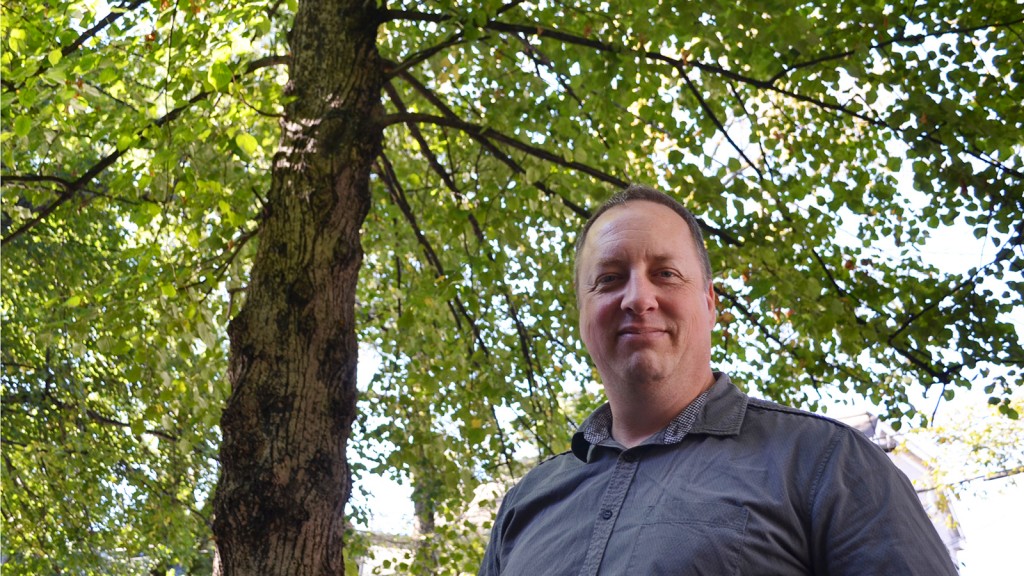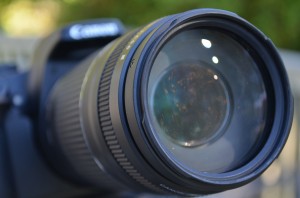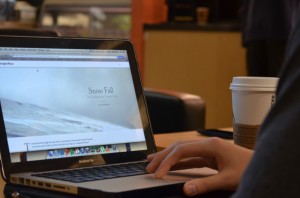A Golden Age of Visual Storytelling

caption
After 16 years at the Chronicle Herald, staff photographer Eric Wynne made the switch to multimedia editor.How multimedia is changing journalism
Rick Conrad, in early summer 2014, walked through the doors of the Halifax Chronicle Herald loaded with armfuls of beer. He was a popular guy.
On most days, the Chronicle Herald staff passing beers around in the middle of the afternoon may appear slightly unprofessional. On this particular day, they were hard at work.
Conrad, the Chronicle Herald web editor, bought dozens of beers for the staff to take home and sample for the Nova Scotia Craft Brewery Guide. The guide explores the Nova Scotia craft beer industry with videos, recipes and reviews from the Herald staff. The feature was published on the Herald’s website, but looks nothing like the rest of the site.
The guide prioritizes a user-friendly design and uses a slew of multimedia elements. Conrad wanted to do something different from the rest of the Chronicle Herald’s online output. Text scrolls fluently, photos and videos are in the spotlight and a map lets users easily navigate the page. While the story is all about beer, the design feels relaxed and restrained and is eye-catchingly beautiful.
The Herald’s craft beer guide is an example of an increasingly prominent type of journalism on the web. A wave of multimedia storytelling is ushering in a new golden age for visual journalists. As many photographers, videographers and data journalists will tell you, the web makes visual storytelling easier, cheaper and more interesting than ever before. While newsrooms slashed jobs over the past few years, many journalists took on new roles working with multimedia. Conrad was the Herald’s education reporter eight years ago. He, like many other journalists, found a new home online creating informative, visually stunning journalism with new multimedia tools and skills.
To talk about multimedia, it’s important to know exactly what it is. “Multimedia is literally the definition of the word,” says Jennifer George-Palilonis, “multiple forms of media.”
George-Palilonis is the author of the 2013 book The Multimedia Journalist: Storytelling for Today’s Media Landscape, and multimedia professor at Ball State University in Muncie, Indiana. She says many print journalists, when the web was beginning to emerge, thought of multimedia in a “marginalizing” way. For example, George-Palilonis said, to many print journalists the definition of multimedia was just video, because that’s all they thought the web could add to their stories.
She said multimedia is now about combining elements including photos, videos, graphs, maps and text. “Multimedia is when we bring together multiple media formats to tell a single story.”
Stanton Paddock, an assistant professor of journalism at Concordia University, says multimedia has developed and gained popularity because different people take in information in different ways.
“When we present journalism just in one way – just text, just television – we’re not playing to the strengths of a good number of our audiences,” he said. “But if we tell the story using different media… it opens it to a wider audience.”
Eric Wynne worked with the Chronicle Herald for 16 years, but recently made a big career move. Wynne, previously a staff photographer, made the switch to multimedia editor. “I did it because I was afraid,” Wynne says. “I still like being employed. I still like paying my bills.”

caption
Herald multimedia editor Eric Wynne says photographs “capture a moment in time” while video can “weave a story.” (Photo: Matt Jamieson)Wynne says opportunities for photographers in print publications are vanishing every day. While he loves the art of photography, he had to find a new way to tell a story. “If you can adapt and you can learn the skills, you can still be employed,” he said. “It just might not be at newspapers.”
Wynne isn’t afraid to say print journalism – words physically printed on paper – is dying. Pointing to his iPhone he said, “It’s all about computer screens on these things, and that’s how people consume it now.”
Wynne envisions the future of journalism to be based online in ever evolving forms of media. This includes a place for photography. “The need for content is never going to change. It’s how it’s presented that’s changing and evolving.”
Wynne occasionally does some still photography for the Herald, but now works mostly with video. He says still photography can “capture a moment in time”, but video can “weave a story.”
He shoots videos for both hard news stories and feature pieces, including the Herald’s beer guide. But he recently tried something new. Wynne created a stop motion video detailing the redecking of the Macdonald Bridge in Halifax. He says it’s the freedom to try something different that makes the web a great platform for journalists to experiment with different types of media.
“Anything that keeps the eyeballs on the page.”
It isn’t just traditional news organizations, like the Herald, experimenting with video. DuckRabbit is a London, U.K.-based digital production and training company making short documentary films incorporating video, audio and still photography. It produces films for commercial, charity and broadcast clients including the BBC, War Child, and Oxfam.
Co-founder and production director Ben Chesterton produced radio documentaries for the BBC before starting DuckRabbit. He says even though he doesn’t work for a traditional media organization, the principles of good journalism remain the same.
“It’s all about finding the right character and spending time with them,” he says. “It’s a really compelling way of telling a story.”
Chesterton said DuckRabbit’s business model and method of storytelling will continue to thrive online as people grow skills and get equipment for a lot less money than they used to.
“It’s not being driven by the broadcasting industry,” he said. “You’ve got an explosion of people who are able to teach themselves and do really amazing work. So I think it’s a very exciting time, just not if you invested £60,000 in a new camera.”
Visualizing data – that is, presenting facts and figures in an understandable and interesting way – is another element of visual journalism thriving online. Charts, graphs and maps are increasingly popular as journalists discover new ways to tell stories visually. Not only can they make complex stories easier to understand, but data visualizations can be informative, compelling and creative. The evolution of data graphics has drastically changed the way people read stories, and revolutionized the way multimedia stories are presented.
“I think it’s a great tool to get people interested,” says Stuart A. Thompson, senior interactive graphics editor at the Wall Street Journal and former multimedia editor at the Globe and Mail. “If you have a dry political story and you can make it cool and interesting, that’s a really good thing.”
Thompson said numbers and charts are intimidating to some journalists, but it’s easier than ever to create compelling web graphics and data visualizations. Still, Thompson cautions journalists to be mindful of misunderstanding data. He said visual journalists often will use a graph or chart “just for the sake of being cool” without stopping to think if it’s the right choice.
He said as long as organizations and journalists understand the clearest way to present data, they have the potential to create great work, even without a lot of money. Not every organization needs the resources of the Wall Street Journal or Globe and Mail, and not every journalist needs a computer science degree, to make a story visually interesting.
“It’s democratization,” he said. “Someone like me who has no background in (computer) programming can pick these things up.
“Charts have always been around. This is just the next evolution of that.”
In May 2013, the Chicago Sun-Times fired all 28 photographers on staff. George-Palilonis – a former design editor at the Sun-Times, who left before the layoffs took place – says many of those photographers were good friends of hers. She describes the layoffs as “incredibly sad, discouraging” and “absolutely the wrong way to go.”
While there was a lot of controversy over those layoffs, it was typical of what was going on, and is still going on, in the newspaper industry. Forty-three per cent of newspaper photographers in the United States have lost their jobs since 2000. That is more than any other category of journalists, including reporters and editors, according to the Pew Research Center in Washington, D.C.
Pew, in its 2014 State of the Media report, says digital news organizations are making up for at least some of the jobs lost in print media. While specific job figures for digital news organizations are difficult to nail down, the research centre surveyed 468 digital news organizations, the majority of which started in the past decade. Pew found they alone created 5,000 full-time jobs in the past 10 years.
In the same report, Pew said digital news organizations are moving towards new forms of storytelling. Digital journalism is increasingly focused on visual storytelling, video and data visualization techniques. These types of online stories, according to Pew, are also becoming cheaper and easier to produce.
There are many great examples of online visual storytelling. One piece is particularly well-known among visual journalists. Snow Fall is a 2012 Pulitzer Prize-winning New York Times feature about an avalanche in the Washington Cascades. The feature changed the way a lot of people think about multimedia and online journalism. The piece racked up 3.5 million page views in its first month, using videos, maps, photos and an eye-catching scrolling effect to hook readers. The article inspired many visual journalists, including Conrad, who says the Herald’s craft beer guide came out of a long-time desire to do something “similar to Snow Fall.”

caption
The New York Times’s Snow Fall brought in 3.5 million page views in less than a month. (Photo: Matt Jamieson)After the article was published many, like the Atlantic’s Rebecca Greenfield, claimed it was the future of journalism. Other journalists, though, saw it as a flawed work.
In August 2014 Roy Peter Clark, senior scholar and vice-president of the Poynter Institute in St. Petersburg, Florida, wrote a critique of Snow Fall published on Poynter’s website. He argued multimedia pieces like Snow Fall must remember storytelling is still important, and can’t be replaced by non-textual elements like flashy graphics and videos.
“I wanted to make sure that people who read my critique of Snow Fall would recognize that it’s a very polite critique and that it recognizes Snow Fall as a signature achievement of multimedia journalism,” Clark says. “But I have to say… the multimedia and textual elements didn’t work in an ideal harmony.”
Clark said the piece could have been stronger if multimedia elements hadn’t interrupted the story and taken the audience out of the experience of reading.
“Storytelling is by definition experiential rather than informational,” he said. “It’s about putting you there, not pointing you there.”
Clark points to another New York Times piece, Tomato Can Blues, as an example of an article in which the storytelling and multimedia elements are “on the same page.” In that case, he said, the multimedia elements help to tell the story, rather than interrupt it.
Moving forward, Clark thinks multimedia storytelling has some catching up to do. “I haven’t seen any multimedia story yet that was as compelling or interesting as Breaking Bad.”
“Everything is a trend,” according to Jennifer George-Palilonis, author of The Multimedia Journalist.
Pieces like Snow Fall changed the way people look at visual storytelling. Prioritizing the way the story looks has proven to help draw readers in and engage them. A wave of multimedia storytelling has since followed, ushering in new opportunities for creativity, innovation and experimentation.
But can this wave sustain itself, or will it burn out?
“Oh god,” George-Palilonis said. “If I had the answer, I could be consulting all over the world.
“It’s not about whether it’s here to stay, but rather that journalists are experimenting and innovating (in ways) that will build our craft and expand our audience.”
Editor’s note: This story was reported and written by Oct. 17, 2014.

